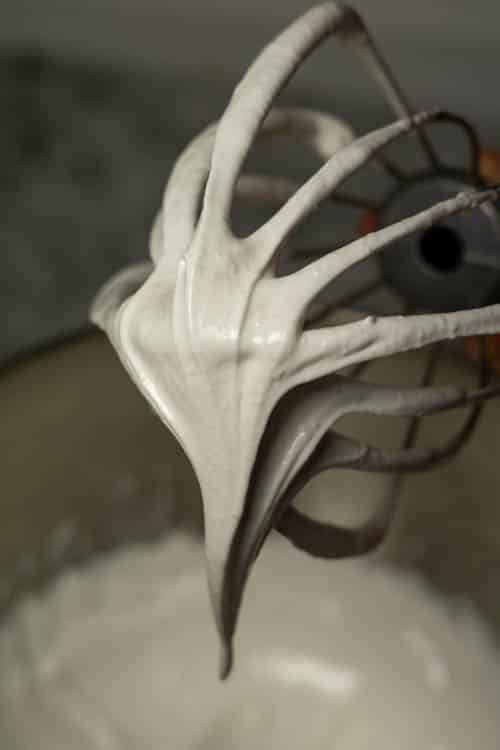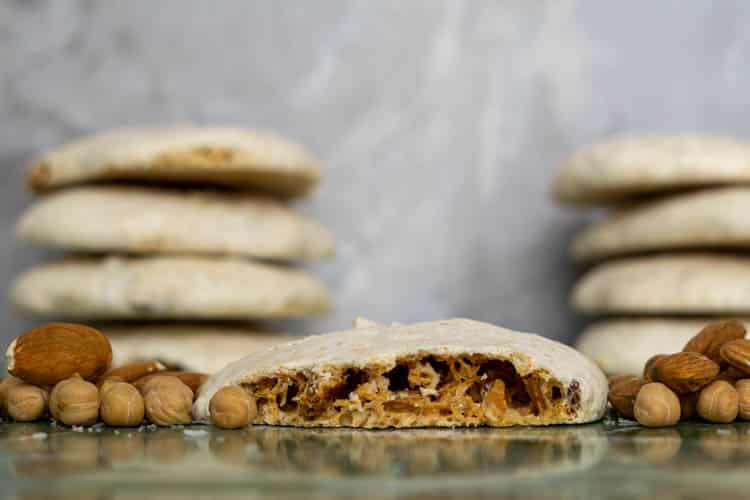Learn the science behind:

How to Use Aquafaba Instead of Egg Whites to Make Meringue
For years, if not decades, meringues, whether Italian, French or Swiss, relied heavily on eggs to make that light and airy texture. If you didn’t eat eggs, meringues were out of the question.
Egg whites are just such a unique mixture of proteins. These proteins just happen to be really good in holding on to air and creating and light and delicate but very stable foam. As such, for a long time, no one really knew of an alternative. That is, until a Frenchmen opened a can of chickpeas and decided to whip up the liquid that comes with the chickpeas (more on that later). All of a sudden, this completely new way to make meringue, without eggs become possible!
Since several of our readers have suggested to use this chickpea liquid to make our marshmallows, it was about time we gave it a try. Instead of going for meringues, we went for the (safer) French (baked) meringue option. It’s just almost surprising how well it worked! But why does it even work?
The invention of aquafaba
Most inventions in food aren’t sudden breakthroughs, instead they are continuous improvements upon existing. It would be impossible to find out who came up with the idea to whip egg whites into a meringue. The invention of this egg white alternative though, is the opposite, it can be traced back to a single person and point in time (although we’ll never know if this person really was the first). Its origin can be traced back to a Frenchman who wrote about his experiments in 2014.
Once he discovered this amazing ingredient, he wrote about it on his blog and started a Facebook group. In this group people started to build and expand on this idea. It was also in this Facebook group that a name for this new ingredient was agreed upon: aquafaba. Aqua stands for water, being the liquid in the can whereas faba stands for beans!

What is aquafaba?
Aquafaba is the liquid in which chickpeas have been cooked. The easiest way to get a hold of it is by buying a can of chickpeas and pouring off the liquid, the liquid is the aquafaba. You can also make aquafaba by cooking your own chickpeas. Both will make a very similar product. The main challenge when making it yourselves though is that the consistency of this liquid should always be similar. If it’s too runny, it likely will not work.
Stability & Consistency
Any fresh egg white (as long as there’s no yolk in it) can be whipped up into a light and airy foam. You don’t have to worry about the type of eggs you buy. All chicken eggs will work. For aquafaba on the other hand, that is not the case.
The properties of aquafaba will depend on how it has been processed. Since aquafaba is the result of a cooking process it isn’t as consistent as eggs. The type of chickpeas used might influence its properties, as might the addition of other
Manufacturers generally manufacture chickpeas, not aquafaba. As a result, they focus on making good chickpeas. They don’t focus on making good chickpea water, aka aquafaba. As such, the aquafaba from different brands may well behave very differently.
Viscosity
The viscosity (ease of flowing) of aquafaba if a measure for how easy it flows. If it’s too runny (especially a risk with homemade one) it won’t form a foam that well. In order to understand this, try to visualize a foam. A foam is nothing more than a lot of tiny air bubbles floating in a liquid. If this liquid is very runny, the air bubbles can escape from this liquid quite easily. If it’s more viscous it won’t do that as easily.

Analyzing aquafaba
Of course, viscosity isn’t the only reason that aquafaba works. Aqaufaba, just like egg whites, contains a mixture of proteins that help to stabilize all these air bubbles. What is interesting though, is that scientists still have very limited visibility as to how this works and which proteins are of importance here!
Egg whites have been used for centuries. In the past decades a lot of scientific studies have been performed on eggs (and whites specifically). As a result, we know fairly well what an egg is made off (see our infographic). This knowledge does not (yet) exist for aquafaba. It wasn’t until 2018 that the first pieces of scientific literature got published on aquafaba, attempting to analyze the composition and its functionality. For now, we know it works, we just don’t exactly know how.
Improving aquafaba
Even though not that much is known and understood about aquafaba from a researchers perspective, some initial work is starting to get published. Researchers for instance looked at the impact of the cooking process of chickpeas on the quality of the aquafaba. Cooking the chickpeas in acid seemed improve the quality.

Using aquafaba to make meringue
What makes aquafaba even more interesting, is that you can use it in the exact same way as egg whites when you’re making meringue (see recipe below for an example). You just whip up the aquafaba with a whisk and then add your sugar. The sugar, as it does for egg whites, stabilizes the whole foam by further increasing the viscosity, making it harder for the air bubbles to escape.
Effect of pH & salt
In order to better understand how aquafaba works researchers have investigated the effect of pH and regular salt (NaCl) on the foaming properties of aquafaba. Both of them don’t seem to have an effect on the stability and size of the foam.

Aquafaba hazelnut meringue
This meringue could also be made with egg whites instead of aquafaba, but here we are using aquafaba of course. The recipe is very flexible and becomes a lot easier if you have an electric stand mixer.
Ingredients
- 90g hazelnuts (with or without skin, both work) - the meringue works without them, but they add a lot of flavour!
- 90g aquafaba
- 175g regular sugar
- 25g icing sugar (add some extra if you want it extra sweet)
- 1 tbsp (15g) corn starch
Instructions
Prepare the hazelnuts
- Roast the hazelnuts until they are a light brown using your preferred method, e.g. place them on a baking tray and roast in a pre-heated oven at 180°C (375°F) for 10-15 minutes.
- Leave the hazelnuts to cool down slightly if you're using a food processor in the next step. If you chop them while they're hot you risk making a paste and setting free liquid fat. If you intend to chop the nuts into small pieces by hand it is easier to do this while they're warm!
- Use a food processor to finely chop the hazelnuts. You don't want to break them down into a fine powder or a paste, instead you want it to be small particles with probably a few larger ones here and there.
Make the meringue
 Aquafaba before it is whipped, it's slightly yellow.
Aquafaba before it is whipped, it's slightly yellow.
- In a stand mixer or using a bowl with a hand mixer, whip the aquafaba until it has formed a light fluffy foam. It does not yet have to be firm.

- Pour in the sugar while whipping, it's best to take a minute or so to slowly add the sugar.
- Continue to whip the aquafaba until the foam is slightly firm. If you would turn the bowl over, the foam should stay put.

- In a separate bowl, mix together the hazelnuts, icing sugar and corn starch. This will prevent the corn starch from clumping when you add it in the next step.
- Using a spatula, fold in the hazelnut mixture into the foam. You want to make sure you mix long enough to get it incorporated homogeneously, but keep it as short as you can so you don't unnecessarily lose any air bubbles.
- You can now decide how you want to spread out your unbaked meringue. In the example it is spread out on baking trays lined with silicone baking mats in circles with a diameter of about 20 cm. You could also cover a whole mat or using a piping bag to pipe round meringues, whatever you prefer.

- Bake the meringue in a pre-heated oven at 180°C (375°F) for about one hour. If you make your meringue thicker it might take somewhat longer.
Storing aquafaba
If your aquafaba comes from a can of chickpeas or your own cooked peas, it cannot be kept long. Aquafaba is full of proteins and carbohydrates, serving as an ideal growing place for moulds and yeasts. Aquafaba can be stored in the fridge, for at least a couple of days. In as little as 4 weeks in the fridge it can be full of moulds!
If you want shelf stable aquafaba you should be looking for a dried version. By getting rid of all the moisture, micro organisms aren’t able to grow as easily.

References
Ania, Homemade aquafaba – vegan egg replacer, June-10, 2016, Lazy cat kitchen, link
Tina F. Buhl, Claus H. Christensen, Marianne Hammershøj, Aquafaba as an egg white substitute in food foams and emulsions: Protein composition and functional behavior, Food Hydrocolloids, Volume 96, 2019, Pages 354-364, ISSN 0268-005X, link
Elyssa Goldberg, Everything You Need to Know About Aquafaba, the Vegan Wonder Ingredient, May-10, 2016, Bon Appetit, link
Tomás Lafarga, Silvia Villaró, Gloria Bobo, Ingrid Aguiló-Aguayo, Optimisation of the pH and boiling conditions needed to obtain improved foaming and emulsifying properties of chickpea aquafaba using a response surface methodology, International Journal of Gastronomy and Food Science, Volume 18, 2019, ISSN 1878-450X, link
Joël R., Révolution végétale, link
What's your challenge?
Struggling with your food product or production process? Not sure where to start and what to do? Or are you struggling to find and maintain the right expertise and knowledge in your food business?
That's where I might be able to help. Fill out a quick form to request a 30 minute discovery call so we can discuss your challenges. By the end, you'll know if, and how I might be able to help.




